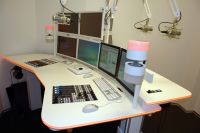 Truly amazing things happen in Switzerland. For example, two of the most beautiful radio studios have paved the way to an even better looking one!
Truly amazing things happen in Switzerland. For example, two of the most beautiful radio studios have paved the way to an even better looking one!
The integration of Radio 105 into one of the two studios of Radio 1 in Zurich led to a lack of a preproduction studio. A new studio was needed and built into what was the former Green Room. The goal was to exceed the high technical standard, design and ergonomics of the already existing studios, which were judged by people who know this sort of thing (such as Jay Tyler, Wheatstone) as the “most beautiful studios ever seen.”
A split 12-channel version of Wheatstone’s flagship LX-24 console was built into a custom made table. (That’s 12 channels on each side.) The table is, of course, electrically adjustable and made out of an artificial stone-like (but still warm) material with LED illuminated edges, which switch to red when one of the mics is active. The audio is fed into a Wheatstone M4-IP four-channel microphone preprocessor before being streamed into the WheatNet-IP audio network. All headphone signals as well as all telephone feeds and returns are level adjusted and processed with a very low delay through the Aura8-IP processing BLADE, truly a marvel in today’s world of audio gear.
The integration of the new WheatNet-IP system into the older non-AoIP system was done with the help of MADI interfaces. The older system was equipped with a MADI plugin card and the WheatNet-IP system was expanded with a MADI BLADE. A fiber optical interconnection made it possible to transfer 2 x 32 stereo channels in between the two systems in both directions. It’s really a highlight in a broadcasting engineer’s life to interconnect so many audio signals between so very differently built and designed systems with one mouse click! Several dozens of hours of soldering XLRs and laying out audio cables are saved that way, an amazing experience indeed!
Another design specialty is the control room monitoring speaker system. It consists of two high quality, 360 degree mid/high loudspeakers and a subwoofer. With this arrangement, the talents enjoy a great sound not only in the middle of the stereo triangle, but practically all around the room. The same is true for the studio guests opposite the DJ. Here, headphones are fed by two TS-4 and one TS-22 talent stations. These use the Wheatstone programmable button feature to also control the height of the studio table.
A large number of computer monitors and touch screens are used, as well. All of these are so-called medicine electronic devices and as such are bright white. This leads – together with a slightly lower position on the DJ side – to a very light and friendly look and an unblocked view from the DJ to the studio guests. The monitors show Wheatstone’s mixing console control screen, the telephone/codec system, the playout system on two screens plus a recorder/editor and a general internet browsing PC. The two monitors at the guest as well as news position are mirroring any two of the DJs monitors.
The entire equipment and studio furniture is bright white. It’s only the computer monitors that add some color and, of course, the Wheatstone LX-24 mixer as a contrast element. A modern power saving 2700K LED illumination of the room leads to a non-fatiguing overall atmosphere that can be adapted to practically any mood (and radio program) with the help of a dimmer. These design elements make the small room appear to be much larger than it is and very comfortable.

